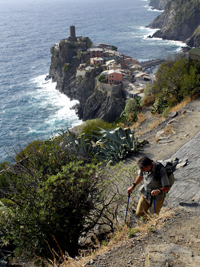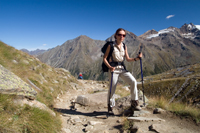- Details
- Written by: David
At Riomaggiore, the station is packed with earnest groups of walkers, mostly elderly Americans, gathered anxiously around guides. I know the Cinque Terre (say chin-kway ter-ray) is a popular destination, but this is definitely not the way to start a peaceful walk along the loveliest stretch of the Ligurian coast. Ten minutes later, though, in company with three voluble local women, I have left the crowds far behind me and am sitting on a country bus winding up mist-covered hills to the village of Volastra. Finally alone, with the haze slowly clearing to reveal the sparkling Mediterranean below, I disembark and set off on my walk.
The Ligurian coast, flanked by the high mountains of the Italian Alps to the north, is crisscrossed with ancient trails that predate Christianity. The promontory of the Cinque Terre – literally the ‘five lands’ – is a UNESCO World Heritage site comprising five villages, the coastline and surrounding hillsides, its steep mountains dropping precipitously to the sea. Before the railway arrived at the beginning of the 20th century, the only means of travel in this rugged, beautiful area were either infrequent coastal boats or on the same paths I am walking today.
The track passes through vineyards planted on narrow terraces, which run like contour lines along the steep slopes. I am wondering how pickers manage to harvest their grapes, when the rattle of an engine breaks into my reverie and a ramshackle motor-powered trolley on a single track heaves into view. A burly man in his thirties leaps down and begins loading boxes stacked high with grapes. I ask him how – and why – he does it. ‘It’s hard work,’ he replies, smiling, ‘but where else could you find such a beautiful view?’ With a friendly ‘Ciao!’ he climbs back on board and, with a squeal of gears, the monorail trundles on up out of sight. I pass only one other walker in the morning, and at midday take a lower trail to the sea and the narrow streets of the tiny village of Corniglia for a light lunch of anchovies washed down with white wine from the slopes above.
In the afternoon, I take a path that runs close to the sea along abandoned terraces overshadowed by holm oaks and the occasional grove of olive trees to Vernazza, a collection of houses perched on a point above a small harbour. Here, over a cold beer, I watch fishermen heaving their boats on shore as a sudden set of large waves comes surging around the sea wall. At 4pm, with a mass of livid cloud gathering on the horizon, I set out again, to arrive an hour later at Monterosso al Mare as the storm finally hits. Huge breakers crash on the pebbly beach in front of the tiny railway station. I take the train to the fishing town of Deiva Marina and my hotel for the night, blessing my luck as squalls of rain beat against the windowpane.
Continued...
 On the edge
On the edge
Next morning dawns clear, and I take a train the roughly 25km to the pretty village of Camogli, and the promontory of the Parco Naturale Regionale di Portofino. The map indicates that the walk to San Fruttuoso at the tip of the headland, accessible only by sea or on foot, is difficult in sections, but after an easy hour strolling on high cliffs above the wide expanse of the Golfo Paradiso, I start to wonder what all the fuss is about. Then, suddenly, the track seems to peter out and, clinging to chains fixed onto the rock face, I make cautious progress on a path only inches wide, trying not to look down to the glittering sea far below.
Finally, after one vertiginous hour, the track leads down into a steep-sided cove and the distant sound of a choir wafts up through the trees. Thinking I might have been in the hot sun too long, I emerge to find a group of Italian pensioners, sitting in the cliff’s shade, singing with gusto. The old, abandoned Benedictine abbey of San Fruttuoso stands above, and a very tempting sea laps on the pebbly beach. There is, however, one vital element missing: I have no swimming trunks. At the little beach café, I haggle hard but to no avail, with the elderly owner clearly knowing when she is onto a winner. Minutes later, and €10 lighter, I swim out in the clear water wearing a pair of fluorescent shorts that would put a Bondi Beach lifesaver to shame. Drifting on my back, the pensioners’ songs wafting over the waves, I look up at the old abbey, thinking that the Benedictine monks could have hardly found a more beautiful and secluded place.
After a lazy couple of hours on the beach, I take a boat back beneath the steep cliffs to the pretty port of Recco, where an express train speeds me to Finale Ligure, around 50km from the French border. The Italian Alps here are at their closest to the sea, and after an hour and a half’s bus ride the next morning, I arrive at the tiny winter skiing resort of Verdeggia. Here, my walking guide, Marco, a lean man in his fifties, marshals the small group of walkers as we set off to climb Monte Saccarello, at 2,201m the highest peak in the Ligurian Regional Alpine Park. It’s a busy place. An avalanche of sheep pursued by barking dogs fills the trail, closely followed by a group of shepherds... and then a group of mountain bikers comes speeding past in a cloud of dust.
Now we are on the Alta Via, Liguria’s highest trail, which winds for 400km through the mountains at over 1,000m. As if on cue, a massive bird flies over so close we can hear the wind hissing through its feathers. ‘A royal eagle!’ shouts Marco above the wind, and we watch the bird swoop on down, eventually disappearing against the backdrop of the Alps.
I have lunch sitting on a boulder astride the Italian/French border as Marco tells us that many of the paths here were used by smugglers, and more recently by illegal immigrants heading north from the Italian coast. As we descend, the landscape changes from alpine meadowland, blanketed by beautiful spring flowers, into woods of pine and larch. Suddenly, two chamois spring from cover and run down the rocky hillside.
In the dying light of the sun, we cross back into Italy for the last time and come down into the narrow valley to wait for the bus. I brace myself for the return of the crowds that will break my 72 hours of solitude.
Make a meal of it
With such a variety of landscapes and climates, Liguria has a reputation for the rich quality and variety of its agricultural produce and cuisine.
Near Portofino, try the focaccia served slightly salted with olive oil for your breakfast, while in and around Genoa, go for prescinseua, a Ligurian acid-cured fresh cow’s milk cheese often served between two wafer-thin slices of focaccia.
Ligurian pesto is Italy’s best, and each town produces its own variety – the Genoese claim to have invented the sauce, and the city has the world’s highest consumption of basil. In Recco, famous for its pesto and focaccia, pesto is served with tagliatelle, gnocchi, or trenette (egg noodles).
The mountains and wooded valleys produce many kinds of mushrooms. Try funghi ripieni stuffed with parmesan and breadcrumbs with oregano and marjoram. Other specialities in the hills are salsa di noci, a delicious creamy sauce of walnuts, parmesan and garlic served with pasta; cinghiale, which is wild boar prepared with olives and potatoes; and the popular coniglio in umbido (rabbit stew). With such a long coastline, seafood is prominent on restaurant menus. Try the burida, a seafood stew, or fresh anchovies marinated in lemon juice.
Trip Notes
Flights
Ryanair ryanair.com flies to Genoa and Milan Bergamo (for northern Liguria) and to Pisa (for the Cinque Terre) from various UK airports.
Flybe flybe.com flies to Nice (close to northern Liguria) from various UK airports. British Airways flies to Genoa, Milan, Pisa and Nice.
Park information
Parco Nazionale delle Cinque Terre
Parco Naturale Regionale di Portofino
Climate
Don’t forget to take plenty of water with you – temperatures in Liguria in May and June can reach a warm 22°C (it’s cooler in the mountains). Temperatures in the night drop to around 7°C. There is about 7-8 hours of sunshine a day in May and June, and monthly rainfall is about 50mm-60mm.

 A less travelled path...
A less travelled path...

